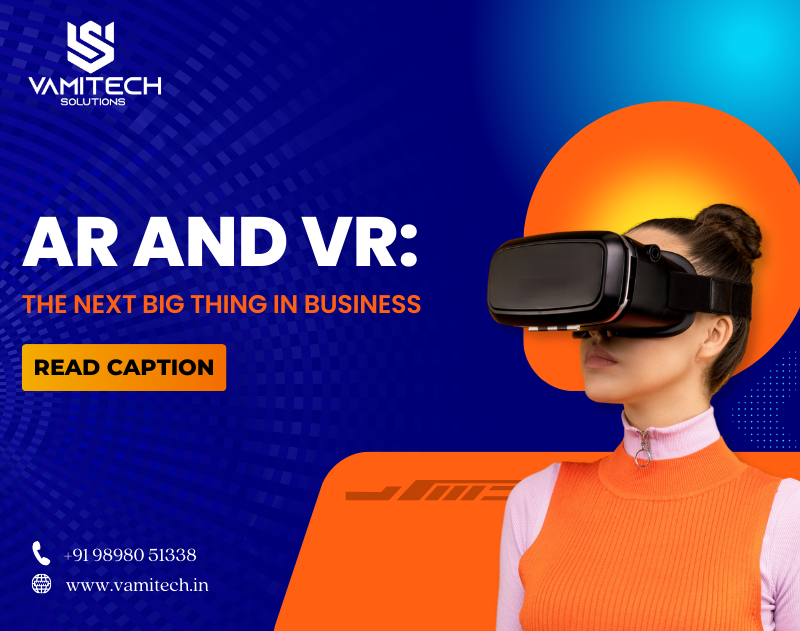
Augmented Reality (AR) and Virtual Reality (VR) are no longer just buzzwords in the tech world; they are becoming transformative tools for businesses across various industries. These technologies, once seen primarily in gaming and entertainment, are now being harnessed to create immersive experiences, enhance productivity, and revolutionize customer engagement. At VamiTech, we believe that AR and VR are the next big thing in business, offering endless possibilities for innovation and growth.
AR & VR Technology Articles
Augmented Reality (AR) overlays digital content onto the real world, enhancing the physical environment with computer-generated images, sounds, and information. This technology is accessible through smartphones, tablets, AR glasses, and other devices, allowing users to interact with digital elements while still being aware of their surroundings.
Virtual Reality (VR), on the other hand, creates a fully immersive digital environment, transporting users into a completely virtual world. VR typically requires specialized headsets, such as the Oculus Rift or HTC Vive, which block out the real world and replace it with a 3D simulated environment that users can explore and interact with.
How AR and VR Are Transforming Business
AR and VR are reshaping the way businesses operate, offering new ways to engage customers, train employees, and streamline processes. Here are some key areas where these technologies are making a significant impact:
1. Enhanced Customer Experiences
Retail and E-commerce:
AR allows customers to try on clothes, accessories, or even makeup virtually before making a purchase. VR can create immersive shopping experiences, such as virtual showrooms, where customers can explore products in 3D. This not only enhances customer satisfaction but also reduces return rates by helping customers make more informed decisions.
Real Estate:
VR is revolutionizing the real estate industry by allowing potential buyers to take virtual tours of properties from anywhere in the world. AR can be used to visualize renovations or interior designs, giving clients a clear idea of what a space will look like before making any changes.
Automotive:
Car manufacturers are using AR to offer virtual test drives, where customers can experience driving a car in a simulated environment. VR showrooms allow customers to explore different car models and customize them to their preferences.
2. Improved Training and Education
Employee Training:
VR is becoming a powerful tool for employee training, especially in industries that require hands-on experience. For example, VR simulations can be used to train pilots, surgeons, or factory workers in a risk-free environment, allowing them to practice and refine their skills before performing real-world tasks.
AR in Education:
AR is enhancing educational experiences by bringing textbooks and lessons to life. Students can interact with 3D models, explore historical sites, or even conduct virtual experiments, making learning more engaging and effective.
3. Product Development and Design
Prototyping:
AR and VR enable businesses to create and test product prototypes in a virtual space before moving to physical production. This reduces costs and speeds up the development process, as designers can easily make adjustments and visualize the final product.
Collaboration:
Teams across different locations can collaborate in a shared virtual environment, working together on product designs or project plans as if they were in the same room. This enhances communication and reduces the need for travel.
4. Marketing and Branding
Immersive Marketing:
AR and VR open up new avenues for creative marketing campaigns. Brands can create immersive experiences that engage customers on a deeper level, such as virtual tours of a new product launch, interactive advertisements, or AR-powered scavenger hunts.
Brand Differentiation:
Companies that leverage AR and VR in their marketing strategies can stand out from competitors by offering unique, memorable experiences that resonate with consumers.
5. Operational Efficiency
Remote Assistance:
AR can be used to provide remote assistance and troubleshooting in real-time. For instance, technicians can use AR glasses to receive visual guidance while repairing equipment, reducing downtime and improving efficiency.
Data Visualization:
AR and VR can transform data visualization by allowing businesses to interact with complex data sets in 3D. This is particularly useful in industries like manufacturing, logistics, and healthcare, where understanding data patterns is crucial for decision-making.
The Future of AR and VR in Business
As AR and VR technologies continue to evolve, their applications in business will expand even further. The rise of 5G networks will enable faster and more reliable connections, making AR and VR experiences smoother and more accessible. In the future, we can expect to see more businesses integrating AR and VR into their operations, from virtual meetings and conferences to AR-powered customer service.
For businesses looking to stay ahead of the curve, now is the time to explore how AR and VR can be incorporated into their strategies. Whether it’s enhancing customer experiences, improving training programs, or streamlining operations, AR and VR offer innovative solutions that can drive growth and competitive advantage.
How VamiTech Can Help
At VamiTech, we specialize in developing AR and VR solutions tailored to the unique needs of your business. Our team of experts works closely with you to understand your goals and create immersive experiences that deliver real value. Whether you’re looking to implement AR in your marketing campaigns, develop a VR training program, or explore other applications of these technologies, VamiTech has the expertise to bring your vision to life.



No comment yet, add your voice below!